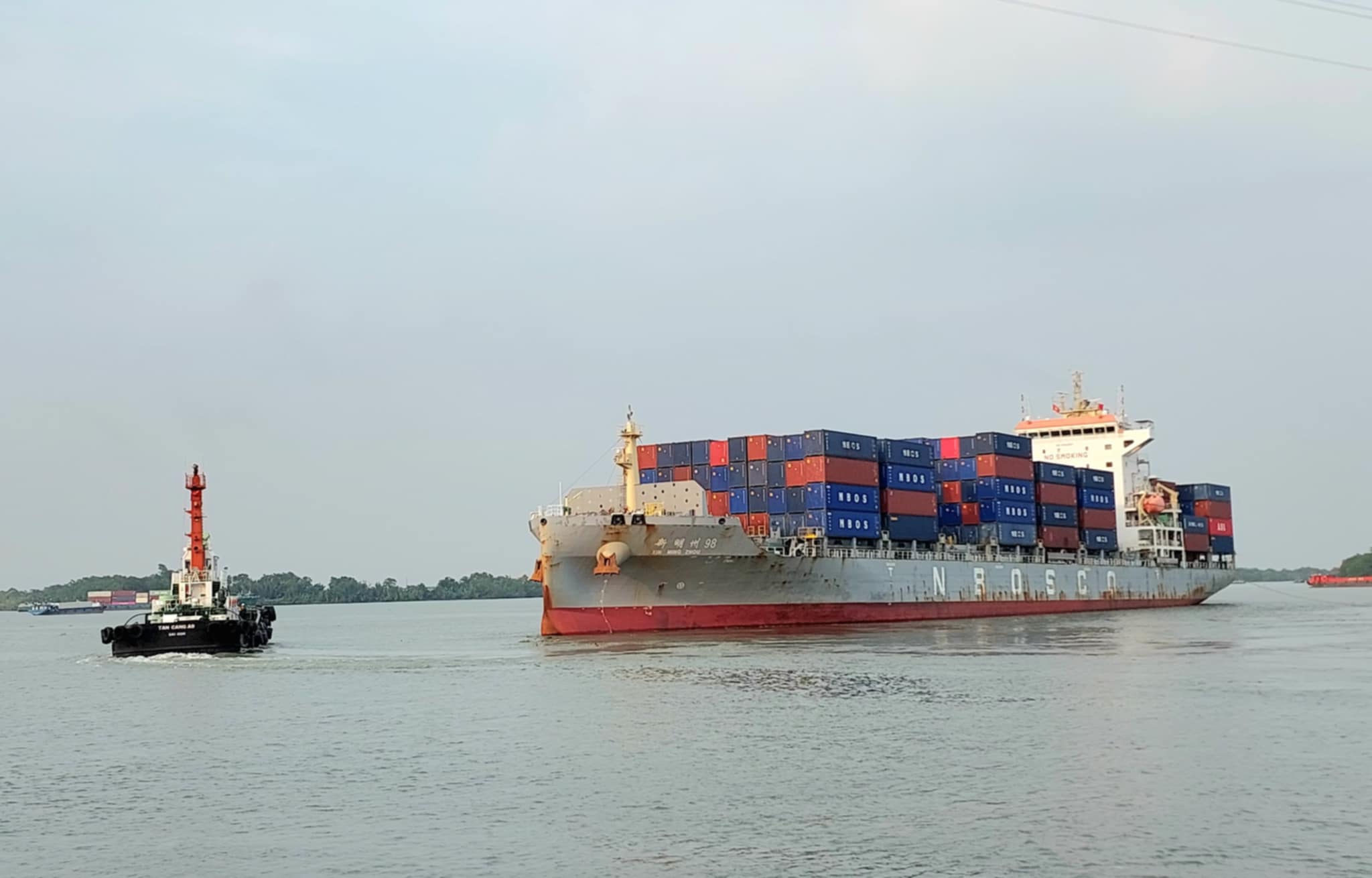The number of ships entering and leaving Ho Chi Minh City seaports tends to increase slightly, while the total number of large-tonnage ships entering and leaving seaports decreases from 2,380 ships (in 2019) to 2,170 ships (in 2023).
The output of goods is growing.
According to statistics from the Vietnam Maritime Administration, over the past 5 years, the total volume of goods through Ho Chi Minh City seaports has increased from more than 124.8 million tons in 2019 to more than 128.2 million tons in 2023.

Currently, Ho Chi Minh City seaport has 6 shipping routes. Of which, the ports in Cat Lai - Phu Huu area are currently one of the main ports of Ho Chi Minh City seaport with high density of ships and efficient exploitation.
In the Project to study and improve the exploitation capacity of public maritime infrastructure and existing port infrastructure, which was recently submitted by the Vietnam Maritime Administration to the Ministry of Transport , Ho Chi Minh City seaport (Group 4) has 40 ports with 99 hard-structured wharves. The total length of the wharves is about 14,917m.
Cat Lai - Phu Huu port area has 8 ports with 19 wharves, total length of 3,554m. Of which, there are 15 container, general, bulk wharves with length of 3,054m to receive ships with tonnage from 20,000 DWT to 45,000 DWT with reduced load; 3 liquid/gas cargo wharves with length of 348m to receive ships up to 32,000 DWT and 1 decorative wharf in the ship repair and building factory with length of 152m to receive ships with tonnage up to 10,000 DWT.
Hiep Phuoc port area has 11 ports with 23 wharves, total length of 3,886m. Of which, there are 16 container, general, and bulk wharves with a length of 2,881m to receive ships with a capacity of up to 50,000 DWT; 2 liquid/gas cargo wharves with a length of 478m to receive ships with a capacity of 4,000 DWT to 20,000 DWT and 5 other ports (barge wharves) with a length of 527m to receive ships with a capacity of up to 2,000 DWT.
The Saigon River port area has 10 ports with 36 wharves, total length of 5,341m. Of which, there are 34 container, general, and bulk wharves with a length of 5,040m, receiving ships with a capacity of 10,000 DWT to 60,000 DWT with reduced load; 1 liquid/gas wharf with a length of 178m, receiving ships up to 3,000 DWT and 1 shipbuilding industry wharf with a length of 123m, receiving ships up to 10,000 DWT.
Currently, Saigon port in Nha Rong - Khanh Hoi area is completing relocation procedures, mainly receiving international passenger (tourist) ships, serving business boats operating restaurant services on the river.
Nha Be port area has 11 ports with 21 wharves, total length of 2,136m. Of which, there are 2 general and separate wharves with length of 204m to receive ships with capacity from 1,000 DWT to 20,000 DWT; 14 liquid/gas cargo wharves with length of 1,507m to receive ships with capacity from 600 DWT to 40,000 DWT and 5 wharves belonging to shipyards and public service with total length of 425m.
Some waterways are still shallow.
Currently, in the seaport waters of Ho Chi Minh City, there are 6 shipping routes in operation, including Saigon - Vung Tau, Soai Rap, Dong Nai, Dua River, Dong Tranh - Go Gia and Tien River.
Assessing the ability to receive large tonnage ships of the shipping routes in Ho Chi Minh City, according to the Vietnam Maritime Administration, the Saigon - Vung Tau shipping route is regularly dredged and maintained to reach a depth of 8.5m (Naval chart) and can receive ships with a tonnage of 80,000 DWT with suitable draft to enter, leave, and load cargo in the Thieng Lieng area, Nga Bay River.
At the same time, it can receive ships with a capacity of up to 60,000 DWT with suitable draft to enter, leave, and load cargo at the wharf area on the Saigon River, Cat Lai - Phu Huu wharf area, and Nha Be wharf area.
The Dong Nai waterway (to Tac Thay Bay junction) connects with the Saigon - Vung Tau waterway in the Nha Be River area. The Dong Nai waterway is regularly dredged and maintained to a depth of 8.5m (Naval chart), ensuring synchronization with the Saigon - Vung Tau waterway.
This is a relatively stable shipping channel with low sedimentation. The ports in the Cat Lai - Phu Huu port area are currently one of the main ports of Ho Chi Minh City with high density of ships and efficient exploitation.
Soai Rap waterway route has the ability to directly connect to the port infrastructure of Can Giuoc wharf area (belonging to Long An seaport) and Hiep Phuoc wharf area of Ho Chi Minh City seaport.
According to the decisions announcing the wharf's use, the wharf in Can Giuoc wharf area is capable of receiving container ships and general cargo ships with a capacity of up to 70,000 DWT (wharf No. 6 in Long An international port). The wharf in Hiep Phuoc wharf area is capable of receiving ships with a capacity of up to 50,000 DWT.
However, the depth of Soai Rap waterway still has some shallow strips and shallow points at the beginning of the waterway, so it is not really suitable for large tonnage vessels to travel.
The cost of dredging and maintenance to maintain the design standards of the channel is quite large, while the infrastructure connecting the port area along the channel has not been fully invested to meet the needs of port operations.
The Dong Tranh - Go Gia maritime route was established and put into operation in 2016, connecting seaport infrastructure, ICDs in Ho Chi Minh City area and port infrastructure in Cai Mep - Thi Vai river area, ensuring continuous voyage for ships with a capacity of up to 5,000 DWT to serve the transit of goods.
In the Go Gia River area, the natural depth of the channel is very large, currently meeting the needs of ships with a capacity of up to 120,000 DWT with suitable draft for safe journeys. Particularly in the area at the head of the channel, it can meet the needs of ships with a capacity of up to 150,000 DWT for safe journeys to and from buoys.
Regarding the Song Dua shipping route, the Vietnam Maritime Administration assesses that it is capable of accommodating ships with a capacity of up to 5,000 DWT.
The waterway plays an important role in channelization, contributing to reducing the load on the Saigon - Vung Tau maritime waterway, thereby improving safety for ships traveling through sharp curves, often with sedimentation such as An Thanh, Dan Xay, Kervella, and L'est capes.
In addition, the headwater area has a fairly good riverbed width and has been planned with mooring buoys for ships with a capacity of up to 60,000 tons.
Particularly, the Tien River waterway is assessed to not be able to accommodate ships with a capacity of up to 5,000 DWT due to many shallow stretches.
Source: https://www.baogiaothong.vn/luong-hang-hai-tphcm-dap-ung-viec-don-tau-trong-tai-lon-ra-sao-192241103155448223.htm




















































![[Maritime News] More than 80% of global container shipping capacity is in the hands of MSC and major shipping alliances](https://vphoto.vietnam.vn/thumb/402x226/vietnam/resource/IMAGE/2025/7/16/6b4d586c984b4cbf8c5680352b9eaeb0)













































Comment (0)